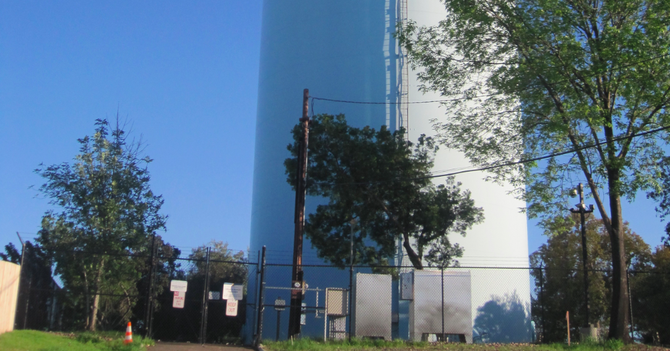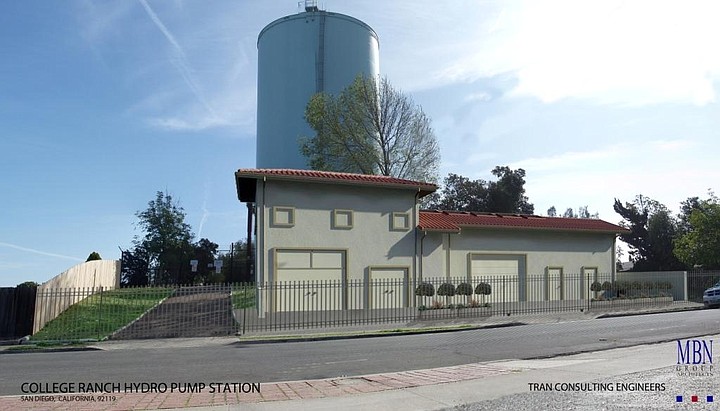 Facebook
Facebook
 X
X
 Instagram
Instagram
 TikTok
TikTok
 Youtube
Youtube

The City of San Diego's plan to demolish and replace a pump station that has served San Carlos since 1967 received unanimous approval from Navajo Community Planners, Inc. (NCPI), on February 25.
The estimated $7.5 million budget covers the planning, design, and construction of a replacement for the College Ranch Hydro Pump Station. The facility and a 102-foot tall standpipe (water tank), located between two houses on Lake Ashmere Drive, provide the community with potable water for daily use and fire protection, said Public Works Department spokesman Scott Robinson in an interview.
The new facility will provide seven million gallons per day; Robinson said that is the anticipated water-supply demand for the year 2030, when the San Carlos population of 4400 is projected to increase to 4650. Construction could start in March 2014 and is expected to take one year.
The new facility will provide water for the area served by the College Ranch and Climax pump stations. The Climax station, built in the early 1970s, is located in an underground vault near the intersection of Cowles Mountain Boulevard and Coleshill Drive. "It will remain in place as a back-up pump station," said Robinson.

The conceptual design, developed by Tran Consulting Engineers, places the 70-foot-long building with heights of 16 feet and 24 feet in front of the standpipe. Robinson said that positioning was based on "available area, access, configuration of existing facilities, and size of the proposed pump station."
Paul Tran, president of Tran Consulting Engineers, elaborated on the design at the meeting of the Navajo planning group.
He said attenuation devices in the building and on the roof will soundproof the facility to the city-required 40-decibel level. While Robinson said the average, normal speaking voice is 65 decibels, Tran said a baby crying is 80 to 90 decibels.
Flat, red roofs and decorative trim on the building will resemble the designs seen on some San Carlos homes. Tran responded to NCPI chair Anthony Wagner's comment that the building would "look Balboa Parkish." Tran said the architect "went through the area and saw red roofs."
San Carlos Area Council president John Pilch said he was concerned about parking during construction. Dwayne Abbey, the city’s project manager, said traffic control plans would be designed. Tran said work would done in phases.
The College Ranch pump station is near the Lake Murray Boulevard shopping center, where Albertsons is a tenant. Pilch suggested that the city "talk to Albertsons about overnight parking."


The City of San Diego's plan to demolish and replace a pump station that has served San Carlos since 1967 received unanimous approval from Navajo Community Planners, Inc. (NCPI), on February 25.
The estimated $7.5 million budget covers the planning, design, and construction of a replacement for the College Ranch Hydro Pump Station. The facility and a 102-foot tall standpipe (water tank), located between two houses on Lake Ashmere Drive, provide the community with potable water for daily use and fire protection, said Public Works Department spokesman Scott Robinson in an interview.
The new facility will provide seven million gallons per day; Robinson said that is the anticipated water-supply demand for the year 2030, when the San Carlos population of 4400 is projected to increase to 4650. Construction could start in March 2014 and is expected to take one year.
The new facility will provide water for the area served by the College Ranch and Climax pump stations. The Climax station, built in the early 1970s, is located in an underground vault near the intersection of Cowles Mountain Boulevard and Coleshill Drive. "It will remain in place as a back-up pump station," said Robinson.

The conceptual design, developed by Tran Consulting Engineers, places the 70-foot-long building with heights of 16 feet and 24 feet in front of the standpipe. Robinson said that positioning was based on "available area, access, configuration of existing facilities, and size of the proposed pump station."
Paul Tran, president of Tran Consulting Engineers, elaborated on the design at the meeting of the Navajo planning group.
He said attenuation devices in the building and on the roof will soundproof the facility to the city-required 40-decibel level. While Robinson said the average, normal speaking voice is 65 decibels, Tran said a baby crying is 80 to 90 decibels.
Flat, red roofs and decorative trim on the building will resemble the designs seen on some San Carlos homes. Tran responded to NCPI chair Anthony Wagner's comment that the building would "look Balboa Parkish." Tran said the architect "went through the area and saw red roofs."
San Carlos Area Council president John Pilch said he was concerned about parking during construction. Dwayne Abbey, the city’s project manager, said traffic control plans would be designed. Tran said work would done in phases.
The College Ranch pump station is near the Lake Murray Boulevard shopping center, where Albertsons is a tenant. Pilch suggested that the city "talk to Albertsons about overnight parking."
Comments